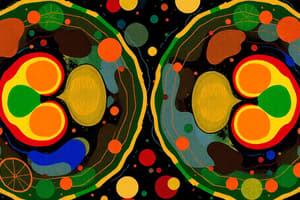Podcast
Questions and Answers
What is the primary purpose of interphase in the cell cycle?
What is the primary purpose of interphase in the cell cycle?
- To grow and prepare the cell for division (correct)
- To resolve DNA mutations before division
- To divide the cell into two daughter cells
- To facilitate communication between cells
Which type of cell division produces genetically identical daughter cells?
Which type of cell division produces genetically identical daughter cells?
- Binary fission
- Mitosis (correct)
- Budding
- Meiosis
Which checkpoint protein is crucial for ensuring damaged DNA is repaired before a cell proceeds to mitosis?
Which checkpoint protein is crucial for ensuring damaged DNA is repaired before a cell proceeds to mitosis?
- Cyclin D
- Rb
- p53 (correct)
- Caspase
How long can interphase last for some cells?
How long can interphase last for some cells?
What happens during prophase in mitosis?
What happens during prophase in mitosis?
How many daughter cells are produced from meiosis in sperm?
How many daughter cells are produced from meiosis in sperm?
Which cells have a limited or no capacity to divide and may remain in the G0 phase?
Which cells have a limited or no capacity to divide and may remain in the G0 phase?
What type of cells are formed when a sperm and an ovum join together?
What type of cells are formed when a sperm and an ovum join together?
In which phase does the actual separation of chromosomes occur?
In which phase does the actual separation of chromosomes occur?
In which condition does cell mutation into a different size, shape, and appearance occur?
In which condition does cell mutation into a different size, shape, and appearance occur?
Meiosis has how many stages in its overall process?
Meiosis has how many stages in its overall process?
What happens to ova as a woman ages?
What happens to ova as a woman ages?
Which type of cellular adaptation is characterized by an increase in the number of cells?
Which type of cellular adaptation is characterized by an increase in the number of cells?
What is a potential outcome of endometrial hyperplasia?
What is a potential outcome of endometrial hyperplasia?
What is formed immediately after fertilization?
What is formed immediately after fertilization?
What is a common factor that triggers dysplasia in the reproductive tract?
What is a common factor that triggers dysplasia in the reproductive tract?
Flashcards are hidden until you start studying
Study Notes
Cell Division Overview
- Mitosis is the most common form of cell division, producing two genetically identical daughter cells.
- Meiosis occurs in gametes (sperm and ova) and results in four haploid cells.
Cell Cycle Phases
- The cell cycle consists of interphase and mitosis.
- Interphase lasts 18 to 23 hours, during which the cell grows and prepares for division.
- Some cells, like neurons and cardiac cells, remain in the G0 phase, unable to divide.
DNA Quality Control
- Checkpoints during interphase ensure the genome is ready for mitosis.
- The tumor suppressor protein p53 fixes damaged DNA; mutations in p53 can lead to cancer.
Mitosis Stages
- Mitosis involves prophase, metaphase, anaphase, and telophase, lasting about 1 hour.
- In prophase, chromosomes condense and the nuclear membrane disintegrates.
- In metaphase, spindle fibers align chromosomes at the cell's equator.
- Anaphase involves separation of chromosomes to opposite poles.
- Telophase sees the formation of new nuclear membranes around separated chromosomes.
Meiosis Process
- Meiosis has two stages: meiosis I and meiosis II, each with prophase, metaphase, anaphase, and telophase.
- Oogenesis (ova development) and spermatogenesis (sperm development) differ; sperm are produced continuously after puberty, while ova remain in prophase for up to 45 years.
- Meiosis completion in egg cells occurs at fertilization, and aging affects chromosomal quality.
Zygote Formation
- An ovum yields one daughter cell, while sperm produce four, each haploid with 23 chromosomes.
- After fertilization, the zygote forms with 46 chromosomes, combining genetic material from both parents.
Cell Adaptations
- Dysplasia: Abnormal growth of cells in size and shape, potentially reversible and often precancerous.
- Hyperplasia: Increase in the number of cells, leading to an enlarged tissue or organ, can be normal (e.g., wound healing) or pathological (e.g., endometrial hyperplasia).
Key Terms
- Dysplasia: Atypical hyperplasia indicating a change in cell morphology, often linked to carcinogenic exposure.
- Hyperplasia: Increase in cell number, can be triggered by hormonal imbalances or physiological processes.
Important Notes
- Mitosis leads to diploid daughter cells; meiosis results in haploid gametes.
- Aging affects cell division quality in both sperm and ova, influencing reproductive outcomes.
Studying That Suits You
Use AI to generate personalized quizzes and flashcards to suit your learning preferences.





